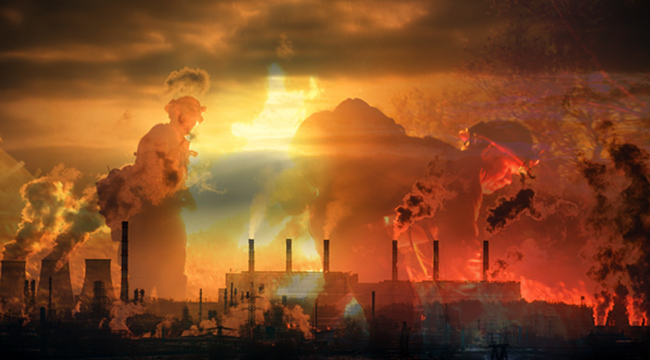Our planet breathes, much like we do, and that means, over time, carbon dioxide levels dip and rise as trees absorb carbon in the spring and summer and release it when their leaves fall. September is typically the low water mark for the yearly atmospheric CO2 levels, but what does it mean when they don’t drop as low as expected?
The Carbon Dioxide Tipping Point, Explained
The basic problem climate scientists have discovered is that this year the amount of carbon dioxide in the atmosphere hasn’t dipped below 400 parts per million (as measured from Hawaii’s Mauna Loa observatory). Considering that carbon dioxide gas most commonly associated with climate change, that’s a bad thing. For a quick, handy summary of how climate change works, and the indescribable environmental bummer it can prove to be, let’s turn to Futurama:
So what’s a tipping point? Basically it’s like a glass of water sitting on your table. If you leave it alone, it’s just going to stay there, being inoffensive and offering hydration. Knock it over, and it will stay on its side, with all the water running out. That’s the tipping point: A transition from one state, to another.
This isn’t the first ecological tipping point we’ve experienced, either. Back in 2005, we hit a tipping point in which Siberia got so warm that it started unleashing greenhouse gases trapped in the permafrost. That was a tipping point because even refreezing the tundra tomorrow wouldn’t put those gases back in. So what does this tipping point — in which scientists worry we may never get below 400 ppm of C02 ever again — mean for us?
An Uncertain Global Future
That’s the whole problem with the carbon dioxide tipping point: Scientists can only guess, because this is the first time that we’ve been here. Mostly they point to past trends to illustrate likely risks. Stanford researchers have found that carbon emissions are the likely culprit behind the warm winters in the western U.S. and the unusually cold ones in the eastern states, for example, which seems likely to continue.
And that’s just one pitfall. German scientists have uncovered a problem of “blocking patterns” created by climate change and its effects on the jet stream. Blocking patterns can trap hot or wet weather over a certain geographic area for days or even weeks, leading to heat waves and floods. These blocking patterns seem to be responsible for some recent extreme weather events, like the 2010 Russian heatwave that killed 50,000 people and decimated Russia’s wheat crop, and Britain’s soaked 2013 winter that saw record flooding.
All that is bad enough. But it’s easy to forget that the weather is more than a talking point or a cause of tragedy. If extreme weather is the new normal, we’ve already seen proof climate change has political effects.
Does Climate Change Cause Terrorism?
Bill Nye was roundly mocked by Twitter last year when he declared that climate change causes terrorism. But he’s far from alone, and in fact President Obama said, in 2014, that climate change was a serious national security concern:
[Developing World nations] don’t have a lot of margin for error, and that has national security implications. When people are hungry, when people are displaced, when there are a lot of young people, particularly young men, who are drifting without prospects for the future, the fertility of the soil for terrorism ends up being significant, and it can have an impact on us.
Obama wasn’t sharing a personal opinion, the idea that climate change is a “multiplier” for political factors is the considered opinion of the United States Armed Forces. And it’s already causing a crisis halfway around the world.
Syria’s tragic civil war and the refugee crisis it’s caused are political talking points, but what nobody is mentioning is the Syrian drought. Between 2006 and 2009, Syria faced an unprecedented drought that forced millions of Syrians into the country’s cities, looking for work, even as crop failures and the government’s mismanagement of the water supply meant that food prices went up and access to water became valuable.
The drought didn’t touch off the civil war in 2011 by itself, but there were angry, starving, parched people shoved more closely together, and it offered tinder for the match. Remember, the Middle East is so desperate for water, the United Arab Emirates is considering spending a quarter of a trillion dollars to build a mountain and change weather patterns.
What Can We Do?
The main thing to remember is that while our climate may change, it doesn’t have to be an apocalyptic vision like what we see in the movies. We can begin limiting the damage in ways as simple as turning the lights off when we leave the room and walking instead of driving. And as the consequences of climate change become clear, it can focus the minds of politicians and businesspeople, who live on this planet too, after all. A tipping point, scientifically, is just a change in state. They don’t have to be bad, and if we work together, we can reach another, new, better one.







